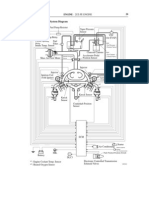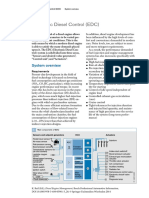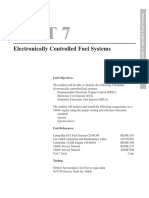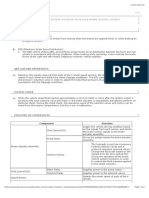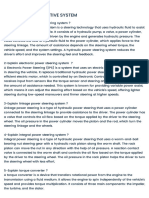Ch7elect Research
Ch7elect Research
Uploaded by
Resource AdvisorCopyright:
Available Formats
Ch7elect Research
Ch7elect Research
Uploaded by
Resource AdvisorOriginal Description:
Original Title
Copyright
Available Formats
Share this document
Did you find this document useful?
Is this content inappropriate?
Copyright:
Available Formats
Ch7elect Research
Ch7elect Research
Uploaded by
Resource AdvisorCopyright:
Available Formats
Section 7
Electronic Throttle Control Systems
Throttle Motor
Throttle Valve
Reduction Gears
Throttle Position Sensor
Throttle Return Spring
L852f809
Lesson Objectives 1. Determine the condition of the ETCS-i system based on engine data
2. Determine the root cause of a failure(s) in the ETCS-i system using the
appropriate diagnostic procedures
Engine Control Systems I - Course L852
Section 7
LEXUS Technical Training
Section 7
Electronic Throttle Control Systems
Electronic Throttle Control
Throttle Motor
System — intelligence (ETCS–i)
Throttle Valve
Reduction Gears
Limp Mode Lever
Throttle Return Spring
Throttle Valve
Throttle Position Sensor
Throttle Position Sensor
Acceleration Pedal
Position Sensor
Magnetic Clutch Fig. 7-01
Throttle Control Motor T852f275/L852f809
Electronic Electronic throttle control system-intelligence(ETCS-i) has several
Throttle advantages over a mechanical linked throttle valve system because the
Control ECM can position the throttle valve for optimum performance under a
Systems variety of conditions.
Overview
In a mechanical system, the ratio between the throttle valve angle and
accelerator pedal position is fixed. This is not desirable under a variety
of conditions. An ETCS-i equipped engine can change the relationship
between the throttle valve angle and accelerator pedal position for opti-
mum engine performance. For example, on vehicles equipped with
Vehicle Skid Control (VSC), ETCS-i will adjust the throttle valve to main-
tain traction on acceleration.
With ETCS-i, the ISC system and cruise control functions are built into
the system. There is no separate ISC or cruise control motor.
Engine Control Systems I - Course L852 7-1
Section 7
There are different versions of the ETCS-i. One version is called a link
type system because there is a cable connected from the accelerator
pedal to the throttle body.
Another version is called a linkless system because there is no mechani-
cal connection from the accelerator pedal to the throttle body.
If the ECM detects an abnormal condition, the engine is put into Fail-
Safe mode and the vehicle under limited power can get home. This is
called the limp home feature. The following is an overview that is com-
mon to both systems.
ETCS-i Throttle
Opening Rate
The relationship between
the accelerator pedal
angle and throttle valve
opening angle changes
Throttle Valve Opening angle
with different modes. Normal-Mode
Power-Mode
Snow-Mode
Accelerator Pedal Angle
Fig. 7-02
T852810
ETCS-i Control The ECM drives the throttle valve to a specified angle as determined by
Modes operating conditions. Different throttle valve angles in relation to the
accelerator pedal position are used to achieve different engine output
characteristics. The following describes the different modes that affect
throttle valve angles. Not all of the following modes are found on all
ETCS-i equipped vehicles.
7-2 LEXUS Technical Training
Electronic Throttle Control Systems
• Non-linear Control - Non linear control means the ECM can control
the throttle valve opening rate and position based on such factors as
accelerator pedal effort and engine output to achieve better perform-
ance and comfort.
• Power-mode Control - On vehicles equipped with a POWER switch,
turning this switch on causes the ECM to increase the ratio of acceler-
ator pedal position to throttle valve angle. The increase engine output
in relation to accelerator pedal position.
• Snow-mode Control - When slippery conditions are anticipated, the
driver can turn on the SNOW switch. This will decrease the throttle
valve opening in proportion with the accelerator pedal position. With
the SNOW switch on, engine output is reduced in relation to accelera-
tor pedal position. This will in vehicle stability and tire traction.
• Shift Shock Reduction Control - The throttle control is synchronized
to the Electronically Controlled Transmission control during the shift-
ing of the transmission to reduce the shift shock.
• Idle Speed Control - The ECM adjusts the throttle opening to main-
tain the target idle speed.
• TRAC Throttle Control - As part of the TRAC system, the throttle
valve is closed by a demand signal form the ABS, TRAC, and VSC ECU
if an excessive amount of slippage is occurring at the driving wheel.
• VSC Coordination Control - VSC performance is enhanced when the
throttle valve opening angle is modified by the ABS, TRAC, and VSC
ECU's.
• Cruise Control - ETCS-i eliminates the need for a separate cruise
control system. Cruise control strategies and functions are incorporat-
ed into the ECM.
ETCS-i Throttle The ECM controls the direction and amount of current needed to activate
Motor Circuit the throttle control motor to adjust throttle valve position. The throttle
Operation motor can be in any one of the following five modes.
• Default position
• Throttle closing
• Throttle opening
• Throttle hold
• Idle speed control
Engine Control Systems I - Course L852 7-3
Section 7
This circuit consists of two transistors on the MO and MC wires. One
transistor supplies power and the other transistor completes the path to
ground. This configuration allows the ECM to control the direction of
current through the motor.
This circuit is also pulsewidth modulated to control the rate of throttle
movement and to hold the throttle in a given position. For rapid throttle
opening, the pulse width duty ratio will be high(current flow high) for
rapid movement.
To hold the throttle in the desired position, the ECM applies enough
current to oppose spring pressure.
If the traction control mode is engaged, the pulsewidth will be less,
limiting the rate of opening from idle. If the throttle valve is opened too
far, the ECM will decrease the pulsewidth closing the throttle.
Default Position When there is no current applied to the motor, the springs hold the
throttle valve in the default position. This condition occurs when the
engine ignition key is off or when the ECM has detected a failure in the
ETCS-i system. In this state, the idle is higher than normal when the
engine is at operating temperature.
Throttle Closing Current flows from the MC to the MO terminal. The MC supply transis-
tor and the MO ground transistor are turned on. The rate the throttle
valve closes is a combination of spring tension, pulsewidth duration,
and direction of current flow. To further close the throttle valve after the
default position, current must flow as shown in the drawing.
Throttle Closing
ECM
+B +B
MC
M
MO
Fig. 7-03
T852f279
7-4 LEXUS Technical Training
Electronic Throttle Control Systems
Throttle Opening Above the default position, the MO supply transistor and MC ground
transistor are turned on allowing current to flow from MO to MC termi-
nals. Below the default position, the current flow direction is the same as
in the throttle close operation, but the pulsewidth is decreased and in
combination with spring tension, the throttle valve opens.
Throttle Opening ECM
+B +B
MC
M
MO
Fig. 7-04
T852f280
Throttle Hold To maintain the desired throttle valve angle, the applied duty ratio creates
enough force in motor to oppose spring pressure.
Idle Speed Control The throttle valve is adjusted to maintain the desired idle speed. If the
desired idle speed needs the throttle valve below the default position, the
throttle close circuit is activated. Any decrease in duty ratio will open the
throttle valve and raise engine RPM. If the desired idle speed needs the
throttle valve above the default position, the throttle open circuit is acti-
vated.
Engine Control Systems I - Course L852 7-5
Section 7
ETCS-i Link The throttle motor operates the throttle valve as described previously.
Type System An electromagnetic clutch connects the throttle motor to the throttle
Operation valve. The throttle position sensor detects throttle valve angle. The
accelerator pedal position sensor detects accelerator pedal position. The
throttle lever is connected by cable to the accelerator pedal. As the driv-
er moves the accelerator pedal the APPS signal voltage changes indicat-
ing a new pedal position. The ECM then adjusts the throttle angle based
on the APPS signals, engine conditions, and vehicle conditions. Later
versions used a thermostat to keep the throttle body at the proper tem-
perature.
ETCS-i Overview
Throttle Valve Throttle Position
Sensor
Accelerator
Position Sensor
Throttle
Control
Motor
Magnet
Clutch
ABS & TRAC
ECM
& VSC ECU
Fig. 7-05
T852f276
7-6 LEXUS Technical Training
Electronic Throttle Control Systems
Thermostat
Thermostat
Wax Valve
To Throttle Body From Water Outlet
Fig. 7-06
T852f277
ETCS-i Link Type The following is description on the function of the major components.
System Component
Operation • Acceleration Pedal Position Sensor (APPS) - The APPS, which is
mounted on the throttle body, is integrated with the throttle lever. The
throttle lever is connected by cable to the accelerator pedal. As the
driver moves the accelerator pedal the APPS signal voltage changes
indicating pedal position. There are two voltage output signals from
the APPS. The ECM uses these two signals to calculate the desired
throttle valve angle. Also, by using two signals the ECM is able to
compare and detect if there is anything wrong with the APPS's per-
formance.
• Throttle Position Sensor - The TPS is used to detect the actual angle
of the throttle valve. This signal indicates to the ECM throttle valve
position and that the throttle valve moved to the desired angle.
Throttle valve position detection is necessary for the ECM to make
adjustments to the throttle valve position and to detect if there is a
failure in the system.
• Throttle Control Motor - The throttle control motor is a DC motor
controlled by the ECM. The ECM controls the direction and the
amperage of the current through the motor. The circuit is pulsewidth
modulated(duty cycle regulated). If there is a malfunction in the sys-
tem, the ECM shuts the circuit (and clutch circuit) off and the return
springs return the throttle to the default position. The ECM will turn
the motor off if there is excessive amperage or not enough amperage
in the motor circuit.
Engine Control Systems I - Course L852 7-7
Section 7
• Magnetic Clutch - Under normal operation, the magnetic clutch
connects the throttle control motor to the throttle valve. The circuit
is pulsewidth modulated reducing power consumption. If there is a
malfunction that will put the ETCS-I into Fail-Safe, the ECM will
turn off the clutch circuit disengaging the motor from the throttle
valve. If the ECM detects too much or not enough amperage in the
circuit, the ECM will turn off the clutch.
• Thermostat - A thermostat is installed on some throttle bodies to
shut off the flow of coolant when coolant temperature is high. This
prevents the throttle body from heating up the intake air reducing
performance. The thermostat uses a wax expansion valve to open
and close the coolant passage.
Fail Safe Mode If an abnormal condition occurs with the ETCS-i, the MIL will illuminate
Link Type to alert the driver. At the same time, current to the throttle control
motor and magnetic clutch are cut off. With no power to the motor or
magnetic clutch, the return spring returns the throttle valve to the
default position. In this situation, called limp mode, the accelerator
pedal operates the limp mode lever. When in limp mode, the throttle can
only be partially opened reducing engine power. The driver will notice
the pedal travel is longer in relation to engine response and that the MIL
is on. Furthermore, ISC and cruise control functions will not operate.
7-8 LEXUS Technical Training
Electronic Throttle Control Systems
ETCS-i Linkless Accelerator Pedal Throttle Valve Throttle Position Sensor
Type System Position Sensor
Throttle
There is no mechanical Control
Motor
link or electromagnetic
clutch with this system.
.
Skid
Control
ECU
Mass Air Distance
ECM Control Laser Radar
Flow Meter Sensor*
ECU*
Passenger
Side J/B Snow Switch
ECU
Ignition Fuel
Coils Injectors
Fig. 7-07
*with Laser Cruise Control L852f811
ETCS-i Linkless The linkless ETCS-i uses a compact throttle body with no mechanical
Type System connection between the accelerator pedal and throttle body. The accelera-
Operation tor pedal position sensor is mounted at the accelerator pedal. As the driv-
er moves the accelerator pedal the APPS signal voltage changes indicating
a new pedal position. The ECM then adjusts the throttle angle based on
the APPS signals, engine conditions, and vehicle conditions. The throttle
position sensor detects throttle valve angle.
This system does not use a magnetic clutch. Operation of this system is
nearly identical to the link type.
ETCS-i Linkless Type The following is description on the function of the major components.
System Component
Operation • Acceleration Pedal Position Sensor (APPS) - The APPS is mounted
at the accelerator pedal. As the driver moves the accelerator pedal the
APPS signal voltage changes indicating pedal position.There are two
voltage output signals from the APPS. The ECM uses these two signals
to calculate the desired throttle valve angle. By using two signals the
ECM is able to compare and detect if there is anything wrong with the
APPS's performance. See Fail-Safe Mode Linkless Type for more infor-
mation.
Engine Control Systems I - Course L852 7-9
Section 7
• Throttle Position Sensor - The TPS is used to detect the actual
angle of the throttle valve. This signal indicates to the ECM throttle
valve position and that the throttle valve moved to the desired angle.
Throttle valve position detection is necessary for the ECM to make
adjustments to the throttle valve position and to detect if there is a
failure in the system. See Fail-Safe Mode Linkless Type for more
information.
• Throttle Control Motor - The throttle control motor is a DC motor
controlled by the ECM. The ECM controls the direction and the
amperage of the current through the motor. The circuit is pulsewidth
modulated(duty cycle regulated). If there is a malfunction in the sys-
tem, the ECM shuts the circuit off and the return springs return the
throttle to the default position. The ECM will turn the motor off if
there is excessive amperage or not enough amperage in the motor
circuit.
Fail Safe Mode There are three different Fail-Safe modes with this system.
3UZ-FE Linkless
Type • Fail-Safe Mode APPS Single Circuit Failure - If either the main or
sub Accelerator Pedal Position circuits should fail, the ECM provides
an active throttle range from idle to approximately twenty-five per-
cent of maximum throttle opening. The driver will notice distinct loss
in power, but has limited control of engine RPM.
Fail-Safe Mode
APPS Single Circuit Failure
ECM
Accelerator Pedal Return Spring
Position Sensor Open
Main Main
Sub
Throttle
Sub Throttle Control
Valve Motor
Accelerator Pedal Throttle Body
Fig. 7-08
L852f812
7-10 LEXUS Technical Training
Electronic Throttle Control Systems
• Fail-Safe Mode APPS Dual Circuit Failure - If the ECM detects a fail-
ure in both circuits of the Accelerator Pedal Position Sensor current to
the throttle motor is turned off, and the force of the return spring
causes the throttle valve to return and stay at a fixed (default) posi-
tion. In this state, engine RPM is fixed. The driver has no control over
engine RPM, but the vehicle will run allowing the vehicle to limp
home.
Fail-Safe Mode
APPS Dual Circuit Failure
ECM
Accelerator Pedal Return Spring
Position Sensor Fixed
Main Main
Sub
Throttle
Sub Throttle Control
Valve Motor
Accelerator Pedal Throttle Body
Fig. 7-09
L852f812
Engine Control Systems I - Course L852 7-11
Section 7
• Fail-Safe Mode TPS Circuit Failure - Any failure of either of the
TPS main and sub circuits causes the ECM to turn off the throttle
control motor and the throttle valve is then held in a fixed (default)
position by the return spring. But in this mode, engine RPM is regu-
lated by controlling fuel injection and ignition timing according to
the APPS signals. The driver will notice a distinct loss in power, but
has limited control of engine RPM.
Fail-Safe Mode
TPS Circuit Failure
Injectors ECM Ignition Coils
Accelerator Pedal Return Spring
Position Sensor Fixed
Main Main
Sub
Throttle
Sub Throttle Control
Valve Motor
Accelerator Pedal Throttle Body
Fig. 7-10
L852f812
Diagnosis The diagnostic procedures for both systems are nearly identical. All
ETCS-i DTCs are one trip DTCs. Retrieve the DTCs and follow repair
manual procedures. The following is a general overview.
7-12 LEXUS Technical Training
Electronic Throttle Control Systems
APPS
There are minor circuit variations with
different APPSs. The circuits are
checked by comparing voltage output
to pedal position.
5v
Close
Output Voltage
VPA2
Open
VPA
0v
E2 VPA2 VPA VC Close Open
Accelerator Pedal Angle
Close 5v
Output Voltage
VPA2
Open
VPA
0v
EP2 VPA2 VPA VCP1 Close Open
VCP2 EP1 Accelerator Pedal Angle
Fig. 7-11
T852f281/L852f815
L852f816/L852f813
Engine Control Systems I - Course L852 7-13
Section 7
TPS
The main and sub TPS circuits are
checked by comparing voltage output to
pedal position. If the TPS needs to be
replaced, it must set according to the
repair manual.
5v
Close
Output Voltage
VTA2
Open
VTA
0v
E2 VTA2 VTA VC Close Open
Throttle Valve Opening Angle
Fig. 7-12
T852f281/L852f814
7-14 LEXUS Technical Training
Electronic Throttle Control Systems
M+ Signal Waveform
Throttle Motor
The throttle motor control circuit operational 5V/Division
check is performed with an oscilloscope.
The RM provides the waveform when
connected to the M+ or M- terminal. The
waveform will vary with a change in throttle
angle. An ohmmeter is used to check the
resistance of the motor coils. GND
1 msec./Division
M– Signal Waveform
5V/Division
GND
Fig. 7-13
1 msec./Division T852f283/T852f282
Electromagnetic Clutch Circuit
Like the throttle control circuit, the clutch CL Signal Waveform
circuit is checked with an oscilloscope. A
normally operating circuit will be a square
5V/Division
wave. An ohmmeter is used to check the
resistance of the clutch coil.
GND
1 msec./Division
Fig. 7-14
T852f284
Engine Control Systems I - Course L852 7-15
Section 7
7-16 LEXUS Technical Training
WORKSHEET 7—1
ETCS-i System
(Instructor Copy)
Vehicle Year/ Prod. Date Engine Transmission
Technician Objectives
With this worksheet, you will learn to test ETCS-i systems using the required tools and equipment, retrieve
and apply the needed service information, retrieve and interpret service data information.
Tools and Equipment
• Vehicle Repair Manual
• Vehicle EWD
• Diagnostic Tester & DVOM
• Hand Tool Set
Section 1
Throttle Control Motor
1. Connect the Diagnostic Tester Auto probe to the throttle motor circuit according to the Repair Manual.
Start the engine and raise engine to approximately 1000 RPM. Draw or print the waveform.
2. Does the waveform match the Repair Manual waveform?
_________________________________________________________________________________________________________
Engine Control Systems I - Course L852 7-17
Worksheet 7—1
3. Raise engine RPM to 2000. What happened to the waveform and frequency? Draw the pattern.
_________________________________________________________________________________________________________
Throttle Clutch (Link Type Only)
1. Connect the Diagnostic Tester Autoprobe to the ETCS-i clutch circuit. Set the Diagnostic Tester to the
Oscilloscope function, according to the RM. Connect DVOM to DC volts, Hz.
2. Start the engine and at idle RPM note the waveform.
3. Does the waveform match the Repair Manual waveform?
_________________________________________________________________________________________________________
4. Draw or print the waveform.
5. What is the frequency?
_________________________________________________________________________________________________________
6. Raise engine RPM to 2000. What happened to the waveform and frequency?
_________________________________________________________________________________________________________
7-18 LEXUS Technical Training
ETCS—i Systems
Go to ETCS-i DATA LIST. Record the following at:
Idle 1700 RPM What parameters changed and why?
Parameter Name DATA DATA
ACCEL POS #1
ACCEL POS #2
THROTTLE POS #2
THROTTLE TARGET
THROTL OPN DUTY
THROTL CLS DUTY
THROTTLE MOT
ETCS MAG CLUTCH*
+BM
ACCEL IDL POS
THROTTLE IDL POS
FAIL #1
FAIL #2
THROTTL INITIAL
ACCEL LEARN VAL
THROTTLE MOT
ETCS MAG CLUTCH*
*If equipped
Engine Control Systems I - Course L852 7-19
Worksheet 7–1
7-20 LEXUS Technical Training
ETCS–i System
Name ____________________________________________________________ Date ________________________________
Review this sheet as you are doing the worksheet. Check each category after completing the worksheet and
instructor presentation. Ask the instructor if you have questions. The comments section is for you to write where
to find the information, questions, etc.
I have questions I know I can
Topic Comment
Locate components in the ETCS-i system
using the EWD and RM
Find wire colors, pin numbers in the fuel
delivery electrical circuits using the EWD
and RM
Locate the ETCS-i Data List and compare
to specs. to determine condition
Test throttle control motor with
oscilloscope
Test clutch with oscilloscpe
Check and retrieve relevant DTCs
Check and retrieve relevant DTCs
Locate in the RM two sections related to
ETCS-i system concerns
Engine Control Systems I - Course L852 7-21
Worksheet 7–1
7-22 LEXUS Technical Training
You might also like
- Speed Secrets Professional Race Driving TechniquesDocument83 pagesSpeed Secrets Professional Race Driving Techniquescruxnexus89% (27)
- International - MaxxForce 10 (2007-09)Document11 pagesInternational - MaxxForce 10 (2007-09)Gus SalazarNo ratings yet
- Servicemanual Peugeot Euro 4 PDFDocument16 pagesServicemanual Peugeot Euro 4 PDFsky100% (3)
- 273243957-DENSO-Common-Rail-Isuzu-6HK1-6SD1-Service-Manual-Pages Backup PDFDocument9 pages273243957-DENSO-Common-Rail-Isuzu-6HK1-6SD1-Service-Manual-Pages Backup PDFjwd100% (1)
- Patrol Y61 2.8 TD Ecu System Operation DiagramDocument9 pagesPatrol Y61 2.8 TD Ecu System Operation Diagramvali_nedelea100% (1)
- K11 CG13DE EmanageDocument1 pageK11 CG13DE EmanagePanq100% (2)
- Engine Control System DiagramDocument8 pagesEngine Control System DiagramGowher QadriNo ratings yet
- 3grfse 1Document42 pages3grfse 1Zoli Borbely100% (3)
- Siemens MS43 SystemsDocument26 pagesSiemens MS43 SystemszefrenchNo ratings yet
- 99759-5C100 SM Controller FB16NT-20NTDocument223 pages99759-5C100 SM Controller FB16NT-20NTmohammed60% (5)
- ECM Daewoo MatizDocument5 pagesECM Daewoo Matizwnsd88% (8)
- 3.0.1 Elektric CM 1250, ENDocument75 pages3.0.1 Elektric CM 1250, ENthuan100% (1)
- Mitsubishi Engine 4M41 Service Repair ManualDocument108 pagesMitsubishi Engine 4M41 Service Repair ManualBambang Suharso100% (6)
- Common Rail Hino - ToyotaDocument41 pagesCommon Rail Hino - Toyota0808833892% (24)
- Acelerador ElectronicoDocument14 pagesAcelerador ElectronicoJeferson AnchatuñaNo ratings yet
- Steering 2 TextbookDocument14 pagesSteering 2 Textbookអែម៚ ពីន៚No ratings yet
- Automatic Transmission Control System 1. GeneralDocument16 pagesAutomatic Transmission Control System 1. Generalbob loblaw100% (1)
- EPS AND MDPS Steering SystemDocument15 pagesEPS AND MDPS Steering SystemScribdTranslationsNo ratings yet
- Sistema de Control de Acelerador Motor 2ZR-FEDocument12 pagesSistema de Control de Acelerador Motor 2ZR-FESamuel GarzaNo ratings yet
- ETCS-I (Electronic Throttle Control System-Intelligent)Document9 pagesETCS-I (Electronic Throttle Control System-Intelligent)ShzllNo ratings yet
- Unit 7: Electronically Controlled Fuel SystemsDocument8 pagesUnit 7: Electronically Controlled Fuel SystemsArmando HenríquezNo ratings yet
- Electronic Diesel Control - WikipediaDocument19 pagesElectronic Diesel Control - Wikipediamei jonieNo ratings yet
- System: Section 2Document72 pagesSystem: Section 2Tú Xuân Lương100% (1)
- 24-113 Electronic Engine Power Control CheckingDocument51 pages24-113 Electronic Engine Power Control CheckingBogdan CojocaruNo ratings yet
- Electronic Diesel Control (EDC) : System OverviewDocument2 pagesElectronic Diesel Control (EDC) : System OverviewRajni Devi100% (1)
- Optimization of PID Control For Engine Electronic Throttle System Using Iterative Feedback TuningDocument8 pagesOptimization of PID Control For Engine Electronic Throttle System Using Iterative Feedback TuningSyed Ahmed AliNo ratings yet
- Electronic Diesel Control Is A Diesel Engine Fuel InjectionDocument4 pagesElectronic Diesel Control Is A Diesel Engine Fuel InjectionRoberto Ortega MicalizziNo ratings yet
- The Engine Is In-Line 4-Cylinders, Water-Cooled, 4-Stroke Cycle MPI Gasoline UnitDocument27 pagesThe Engine Is In-Line 4-Cylinders, Water-Cooled, 4-Stroke Cycle MPI Gasoline UnitGabriel BalcazarNo ratings yet
- 24-120 Electronic Engine Power Control CheckingDocument50 pages24-120 Electronic Engine Power Control CheckingBogdan CojocaruNo ratings yet
- Electric Power Steering - 2Document9 pagesElectric Power Steering - 2Tilahun Worku100% (2)
- 2008 Chevrolet Aveo 2008 Chevrolet AveoDocument3 pages2008 Chevrolet Aveo 2008 Chevrolet AveoRonald FernandezNo ratings yet
- EML System On BMW 12cyl Engines - Theory of OpsDocument6 pagesEML System On BMW 12cyl Engines - Theory of OpsDOMINO66No ratings yet
- 4.1 Engine Management System-R1-1 MINYI EFFADocument24 pages4.1 Engine Management System-R1-1 MINYI EFFARusonegroNo ratings yet
- Electronically Controlled Continuously Variable Transmission (ECVT)Document3 pagesElectronically Controlled Continuously Variable Transmission (ECVT)Virgile HirwaNo ratings yet
- 24-134 Electronic Engine Power Control CheckingDocument41 pages24-134 Electronic Engine Power Control CheckingBogdan CojocaruNo ratings yet
- NYECDocument77 pagesNYECANGELES NIETONo ratings yet
- Tac PDFDocument3 pagesTac PDFZool Car زول كارNo ratings yet
- BccontDocument78 pagesBccontIonut GrozaNo ratings yet
- SECTION 5.00: Speed Governing SystemDocument40 pagesSECTION 5.00: Speed Governing SystemLUISA FERNANDA TORRES MANOSALVANo ratings yet
- INTELLIGENT THROTTLE CONTROL (iTC)Document11 pagesINTELLIGENT THROTTLE CONTROL (iTC)Steven AmadorNo ratings yet
- New Features: 3Uz-Fe Engine (Engine Control System) 1. GeneralDocument2 pagesNew Features: 3Uz-Fe Engine (Engine Control System) 1. Generalbob loblawNo ratings yet
- MEG - Electronic Governor DetailsDocument23 pagesMEG - Electronic Governor DetailsOliver Guido Castro Pinto100% (1)
- UNIT7L1 - 2S - Electronically Controlled Fuel SystemsDocument10 pagesUNIT7L1 - 2S - Electronically Controlled Fuel SystemsEbied Yousif AlyNo ratings yet
- Engine Management: Subject: Mechatronics System Design Submitted To: Engr. Zubair Submitted byDocument6 pagesEngine Management: Subject: Mechatronics System Design Submitted To: Engr. Zubair Submitted byqazi_mohsin87100% (1)
- Engine PerformanceDocument1,301 pagesEngine PerformanceAlexis Yureni Rodriguez Rojas100% (1)
- Componetes Electronicos Cat (056-109)Document54 pagesComponetes Electronicos Cat (056-109)Edgar MaldonadoNo ratings yet
- Report On Electronic Power SteeringDocument14 pagesReport On Electronic Power SteeringSatadru Bera60% (5)
- Electronic Power Control: Self-Study Programme 210Document36 pagesElectronic Power Control: Self-Study Programme 210Paul ChalcoNo ratings yet
- Sensores KV6 Siemens MS43 SystemsDocument26 pagesSensores KV6 Siemens MS43 SystemsLuiz NogueiraNo ratings yet
- Theory OperationDocument20 pagesTheory Operationjuan manuel partida alvarezNo ratings yet
- Electronic Throttle Control System-Intelligence (ETCS-i)Document19 pagesElectronic Throttle Control System-Intelligence (ETCS-i)DoDuyBac67% (3)
- Sistema de Control de EmisionesDocument45 pagesSistema de Control de EmisionesDavid ParariNo ratings yet
- Lexus Es300 Technical TrainingDocument20 pagesLexus Es300 Technical Trainingkelly100% (56)
- ElectronicsDocument4 pagesElectronicsMarcusNo ratings yet
- Modular Engine Management System OperationDocument2 pagesModular Engine Management System OperationYanie YanieNo ratings yet
- Electrically Powered Hydraulic Steering System: New Generation ofDocument3 pagesElectrically Powered Hydraulic Steering System: New Generation ofVrushabh SahareNo ratings yet
- ETCS-i (Electronic Throttle Control System-Intelligent) : GeneralDocument14 pagesETCS-i (Electronic Throttle Control System-Intelligent) : GeneralSajjad Khaliq100% (1)
- Chapter3 Automotive Embedded ApplicationsDocument156 pagesChapter3 Automotive Embedded ApplicationsKomal Kalkutkar100% (1)
- User 'S Guide For MT-DAE: Learning Model: Electric Power SteeringDocument45 pagesUser 'S Guide For MT-DAE: Learning Model: Electric Power SteeringShifat UllahNo ratings yet
- ZX200 - 270W (2) HitachiDocument7 pagesZX200 - 270W (2) Hitachigalvis1020No ratings yet
- System DescriptionDocument2 pagesSystem DescriptionYomar NegronNo ratings yet
- Engine Control UnitDocument7 pagesEngine Control UnittotoNo ratings yet
- Engine Controls & SensorsDocument5 pagesEngine Controls & Sensorsrudey18No ratings yet
- Aas Q&aDocument2 pagesAas Q&aMD HUZAIFA HANDURNo ratings yet
- Starting Systems: Description and Operation Starting SystemDocument14 pagesStarting Systems: Description and Operation Starting SystemLiliana Rebeca Santos santosNo ratings yet
- Control of DC Motor Using Different Control StrategiesFrom EverandControl of DC Motor Using Different Control StrategiesNo ratings yet
- Automotive Electronic Diagnostics (Course 2)From EverandAutomotive Electronic Diagnostics (Course 2)Rating: 4 out of 5 stars4/5 (2)
- Inteligen: Compact Bi-Fuel Governor/ControllerDocument48 pagesInteligen: Compact Bi-Fuel Governor/ControllerRODRIGO_RALONo ratings yet
- Basic Document For Oat552Document15 pagesBasic Document For Oat552SivaNo ratings yet
- Ford Motor Co PID 2 ListDocument7 pagesFord Motor Co PID 2 ListBraydon WilliamsonNo ratings yet
- Abbreviations of Car EquipmentsDocument7 pagesAbbreviations of Car EquipmentsSemajmarx007No ratings yet
- Carburetor ReportDocument7 pagesCarburetor ReportAly MohamedNo ratings yet
- HR15Document416 pagesHR15jmiguel100% (2)
- QSK45 Wiring Diagram (Tier 1, Phase 2.0 With CENSE)Document2 pagesQSK45 Wiring Diagram (Tier 1, Phase 2.0 With CENSE)987226146100% (4)
- Toyota 02-8FGF25 - Multifunction Display (Opt)Document73 pagesToyota 02-8FGF25 - Multifunction Display (Opt)Vitor Hugo100% (3)
- Ford ObdDocument235 pagesFord ObdLuciane Vaghetti100% (5)
- 125 Series Diesel1Document2 pages125 Series Diesel1ashahulhjNo ratings yet
- NGC PCM GenerationDocument154 pagesNGC PCM Generationrnoelectronics60% (5)
- OS 140RX EngineDocument13 pagesOS 140RX EngineJorge Andrés FeliúNo ratings yet
- PINOUTDocument17 pagesPINOUTthisyocatNo ratings yet
- 2022 Spring CatalogDocument39 pages2022 Spring Catalogmjavad40001382No ratings yet
- Diesel Engine Electronic ManagmentDocument10 pagesDiesel Engine Electronic ManagmentRafał AnielewiczNo ratings yet
- Engine MechanicalDocument117 pagesEngine MechanicalВіталій ЛенівNo ratings yet
- Traktor Silnik Parts-ManualDocument29 pagesTraktor Silnik Parts-ManualsmiecietcNo ratings yet
- Toyota ECU ChartDocument8 pagesToyota ECU ChartChonseyNo ratings yet
- VECU - Manual de Producción 70312913Document33 pagesVECU - Manual de Producción 70312913RainorSS100% (2)
- Internal Combustion Engines PresentationDocument23 pagesInternal Combustion Engines PresentationNitesh BirlaNo ratings yet
- Ambac Ec 5010 ManualDocument2 pagesAmbac Ec 5010 ManualGonzalo DominguezNo ratings yet
- Chery Carry A18 ENGINE ELECTRICAL SYSTEM - E PDFDocument89 pagesChery Carry A18 ENGINE ELECTRICAL SYSTEM - E PDFEduar SevillaNo ratings yet






